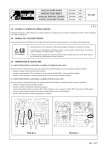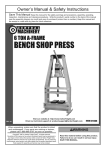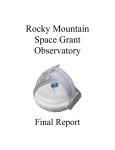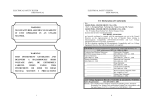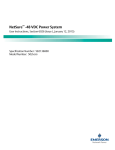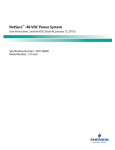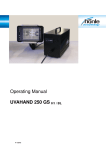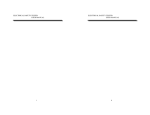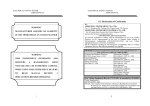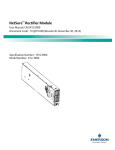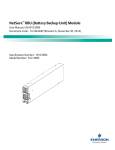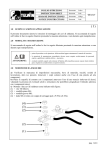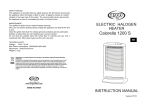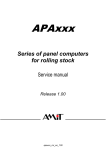Download 952968_ultima versione
Transcript
Cod. 952968 INSTRUCTION MANUAL EXPLANATION OF DANGER, MANDATORY AND PROHIBITION SIGNS DANGER OF ELECTRIC SHOCK DANGER OF WELDING FUMES DANGER OF EXPLOSION WEARING PROTECTIVE CLOTHING IS COMPULSORY WEARING PROTECTIVE GLOVES IS COMPULSORY DANGER OF ULTRAVIOLET RADIATION FROM WELDING WEARING A PROTECTIVE MASK IS COMPULSORY USERS OF VITAL ELECTRICAL AND ELECTRONIC DEVICES MUST NOT USE THE WELDING MACHINE GENERAL HAZARD - The welding machine should be connected only and exclusively to a power source with the neutral lead connected to earth. - Make sure that the power supply plug is correctly connected to the earth protection outlet. - Do not use the welding machine in damp or wet places and do not weld in the rain. - Do not use cables with worn insulation or loose connections. INSTRUCTION MANUAL WARNING: BEFORE USINGTHE MACHINE READ THE INSTRUCTION MANUAL CAREFULLY! LIMITED SERVICE, MANUAL ARC WELDING MACHINES FOR COATED ELECTRODES (MMA) Note: In the following text the term “welding machine" will be used. 1. GENERAL SAFETY CONSIDERATIONS FOR ARC WELDING - Avoid direct contact with the welding circuit: the noload voltage supplied by the welding machine can be dangerous under certain circumstances. - When the welding cables are being connected or checks and repairs are carried out the welding machine should be switched off and disconnected from the power supply outlet. - Make the electrical connections and installation according to the safety rules and legislation in force. -1- - Do not weld on containers or piping that contains or has contained flammable liquid or gaseous products. - Do not operate on materials cleaned with chlorinated solvents or near such substances. - Do not weld on containers under pressure. - Remove all flammable materials (e.g. wood, paper, rags etc.) from the working area. - Provide adequate ventilation or facilities for the removal of welding fumes near the arc; a systematic approach is needed in evaluating the exposure limits for the welding fumes, which will depend on their composition, concentration and the length of exposure itself. ,* - Use adequate electrical insulation with regard to the electrode, the work piece and any (accessible) earthed metal parts in the vicinity. This is normally achieved by wearing gloves, shoes, head coverings and clothing designed for this purpose and by using insulating platforms or mats. - Always protect your eyes using masks or helmets with special actinic glass. Use special fire-resistant protective clothing and do not allow the skin to be exposed to the ultraviolet and infrared rays produced by the arc; other people in the vicinity of the arc should be protected by shields of non-reflecting curtains. - The electromagnetic fields generated by the welding process may interfere with the operation of electrical and electronic equipment. Users of vital electrical or electronic devices (e.g. pace-makers, respirators etc.) should consult a doctor before stopping in the vicinity of areas where this welding machine is used. Users of vital electrical or electronic devices should not use the welding machine. RESIDUAL RISKS - OVERTURNING: position the welding machine on a horizontal surface that is able to support the weight: otherwise (e.g. inclined or uneven floors etc.) there is danger of overturning. - IMPROPER USE: it is hazardous to use the welding machine for any work other than that for which it was designed (e.g. de-icing mains water pipes). - Do not use the handle to hang up the welding machine. 2. I N T R O D U C T I O N A N D G E N E R A L DESCRIPTION This apparatus is a power source for arc welding, made specifically for alternating current (AC) MMA welding with coated electrodes. STANDARD ACCESSORIES: - Electrode holder clamp. - Return cable and earth clamp. 3. DESCRIPTION OF THE WELDING MACHINE CONTROL, ADJUSTMENT AND CONNECTION DEVICES Fig. A 4. INSTALLATION WARNING! CARRY OUT ALL INSTALLATION OPERATIONS AND ELECTRICAL CONNECTIONS WITH THE WELDING MACHINE COMPLETELY SWITCHED OFF AND DISCONNECTED FROM THE POWER SUPPLY OUTLET. THE ELECTRICAL CONNECTIONS MUST BE MADE ONLY AND EXCLUSIVELY BY AUTHORISED OR QUALIFIED PERSONNEL. PREPARATION Fig. B Unpack the welding machine, assemble the separate parts contained in the package. Fit the feets on the welding machine. Assembling the return cable-clamp Fig. C Assembling the welding cable-electrode holder clamp Fig. D weight, to prevent it from tipping or moving hazardously. CONNECTION TOTHE MAIN POWER SUPPLY - Before making any electrical connection, make sure the rating data of the welding machine correspond to the mains voltage and frequency available at the place of installation.. - The welding machine should only be connected to a power supply system with the neutral conductor connected to earth. 5. WELDING: DESCRIPTION OF THE PROCEDURE These welding machines consist of a drooping specification, single phase transformer and are suitable for welding with alternating current using coated electrodes (E 43 R type) based on the diameters given on the data plate . To switch on the welding machine operate the main switch (Fig. A-2). The intensity of the supplied welding current can be adjusted continuously, by means of a manually operated magnetic shunt (Fig. A-4) The value of the output current setting, can be read in Amps on the graduated scale (Fig. A-1) on the top panel of machine. The corresponding arc voltage for the current shown is given according to the following relationship: U2 = (18 + 0,04 I2) V (EN 50060). THERMOSTATIC PROTECTION This welder is automatically protected from thermic overheating (thermostat automatic re-start). When the windings reach performance temperature, the protections cut off the supply circuit, igniting the yellow lamp on the front panel (A-3). After a few minutes’ cooling the protection will reopen the supply line and turn off the yellow lamp. The welder is ready for further use. WELDING - Use electrodes suitable for working in alternating current. - The welding current must be regulated according to the diameter of the electrode in use and the type of the joint to be carried out: see below the currents corresponding to various electrode diameters: ø Electrode (mm) Welding current (A) min. max. 1.6 25 50 2 40 80 2.5 60 110 3.2 80 160 - The user must consider that, according to the electrode diameter, higher current values must be used for flat welding, whereas for vertical or overhead welds lower current values are necessary. - In addition to being determined by the selected current intensity, the mechanical characteristics of the welded join are determined by the other welding parameters i.e. arc length, working rate and position, electrode diameter and quality (to store the electrodes correctly keep them dry and protected by suitable packaging or containers). Welding procedure - Holding the mask IN FRONT OF THE FACE, strike the electrode tip on the workpiece as if you were striking a match. This is the correct strike-up method. WARNING: do not hit the electrode on the workpiece, this could damage the electrode and make strike-up difficult. - As soon as arc is ignited, try to maintain a distance from the workpiece equal to the diameter of the electrode in use. Keep this distance as much constant as possible for the duration of the weld. Remember that the angle of the electrode as it advances should be of 20-30 grades. (Fig.E) - At the end of the weld bead, bring the end of the electrode backward, in order to fill the weld crater, quickly lift the electrode from the weld pool to extinguish the arc. CHARACTERISTICS OF THE WELD BEAD Fig.F WARNING! Position the welding machine on a flat surface with sufficient carrying capacity for its -2- - Inspect the welding machine regularly, with a frequency depending on use and the dustiness of the environment, and remove the dust deposited on the transformer, using a jet of dry compressed air (max. 10 bar). - At the same time make sure the electrical connections are tight and check the wiring for damage to the insulation. - At the end of these operations re-assemble the panels of the welding machine and screw the fastening screws right down. - Never, ever carry out welding operations while the welding machine is open. - If necessary use a very thin layer of grease, at a high temperature, to lubricate the moving parts of the regulators (threaded shaft, sliding surfaces, shunts etc.) 6. MAINTENANCE W A R N I N G ! B E F O R E C A R RY I N G O U T MAINTENANCE OPERATIONS MAKE SURE THE WELDING MACHINE IS SWITCHED OFF AND DISCONNECTED FROM THE MAIN POWER SUPPLY. EXTRAORDINARY MAINTENANCE: EXTRAORDINARY MAINTENANCE OPERATIONS SHOULD BE CARRIED OUT ONLY AND EXCLUSIVELY BY SKILLED OR AUTHORISED ELECTRICALMECHANICAL TECHNICIANS. WARNING! BEFORE REMOVING THE WELDING MACHINE PANELS AND WORKING INSIDE THE MACHINE MAKE SURE THE WELDING MACHINE IS SWITCHED OFF AND DISCONNECTED FROM THE MAIN POWER SUPPLY OUTLET. If checks are made inside the welding machine while it is live, this may cause serious electric shock due to direct contact with live parts and/or injury due to direct contact with moving parts. FIG. A - Replacing the power supply cable: before replacing the cable, identify the screw-connecting terminals L1 and L2 (N) on the switche (Fig.G). 1 3 2 4 FIG. B -3- 1234- Graduated scale Main switch Thermostat trigger light Welding current adjustment FIG. C FIG. D FIG. E FIG. F ADVANCEMENT TOO SLOW ARC TOO SHORT CURRENT TOO LOW CURRENT CORRECT ADVANCEMENT TOO FAST FIG. G ARC TOO LONG CURRENT TOO HIGH L1 -4- L2




